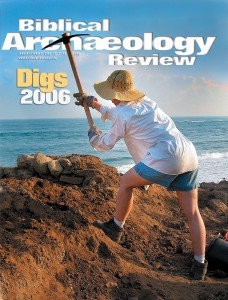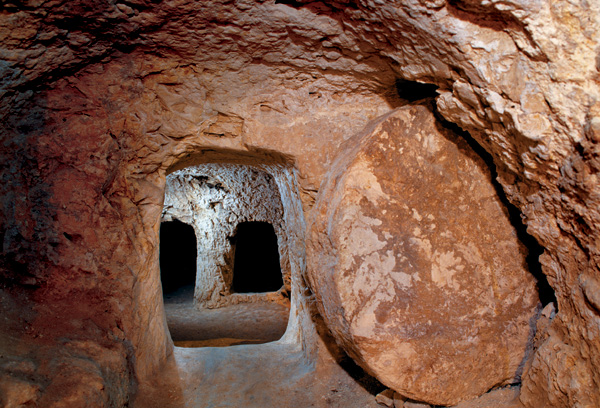
According to the Gospels, Jesus died and was removed from the cross on a Friday afternoon, the eve of the Jewish Sabbath. A wealthy follower named Joseph of Arimathea requested Pontius Pilate’s permission to remove Jesus’ body from the cross and bury him before sundown, in accordance with Jewish law. Because there was no time to prepare a grave before the Sabbath, Joseph placed Jesus’ body in his own family’s tomb.
The reliability of the Gospel accounts—which were written a generation or two after Jesus’ death—is debated by scholars. Most discussions have focused on literary and historical considerations, such as the composition dates of the Gospels and internal contradictions and differences between them. Here, I will consider the account of Jesus’ burial in light of the archaeological evidence. I believe that the Gospel accounts accurately reflect the manner in which the Jews of ancient Jerusalem buried their dead in the first century.
Wealthy Jews in ancient Jerusalem buried their dead in tombs cut into the bedrock slopes around the city. These rock-cut tombs were used by Jerusalem’s Jewish elite only in times when they enjoyed an autonomous or semi-autonomous status. With few exceptions, the tombs were located outside the walls of the city. Each tomb was used by a family over the course of several generations, as reflected in the Biblical expression “He slept and was gathered to his fathers” (Judges 2:10; 2 Chronicles 34:28, etc.)
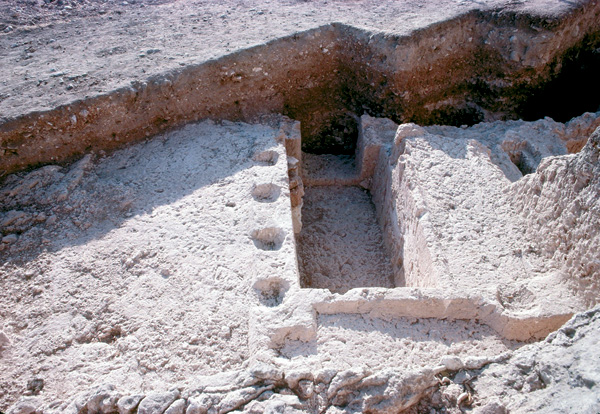
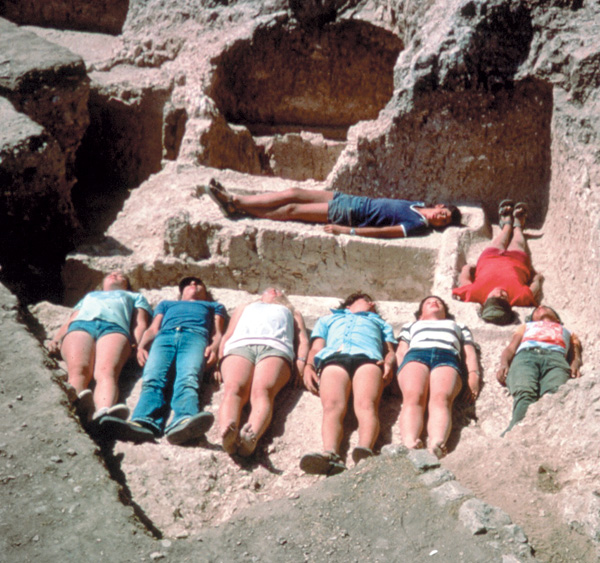
When a member of the family died, the body was wrapped in a shroud, sometimes placed in a coffin and laid in the tomb, even if the bones were later collected and placed elsewhere (either in a separate repository, as in the First Temple period, or, in a later period, in a bone box called an ossuary). Because of the expense associated with hewing a burial cave out of bedrock, however, only upper class and upper-middle class Jerusalemites could afford rock-cut tombs. The poorer members of Jerusalem’s population apparently disposed of their dead in a manner that has left few traces in the archaeological record, for example in simple individual trench graves dug into the ground.
Rock-cut tombs of the late First Temple period (eighth-seventh century B.C.E.) typically consist of one or more burial chambers entered through a small, unadorned opening cut into the bedrock. Each burial chamber is lined with rock-cut benches along three sides on which the bodies of the deceased were laid. Frequently a pit carved beneath one of the benches was used as a repository for the bones of earlier burials; when the benches became filled with bodies, the remains (skeletons and grave gifts) were placed in the repository to make space for new burials on the burial benches.
An undisturbed repository in the Ketef Hinnom cemetery (overlooking the Hinnom Valley, northwest of the Old City) contained large numbers of skeletons as well as the burial gifts that accompanied them, including ceramic vases and oil lamps, jewelry, seals, a rare early coin and two silver amulets.a Many of the decorative elements in these burial caves, such as the carved headrests on the benches, reflect Egyptian styles transmitted directly from Egypt or through Phoenician intermediaries. We shall see foreign cultural influences and fashions again reflected in burials of a later period.
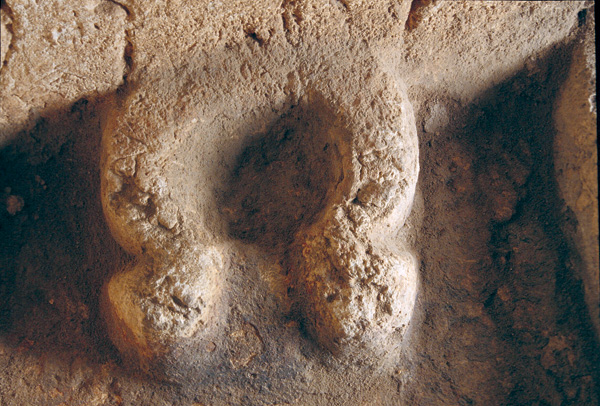
After the destruction of Jerusalem and Solomon’s Temple in 586 B.C.E., archaeological evidence for Jewish burial caves reappears only in the Hasmonean period, when Jerusalem again came under Jewish rule. As a result of the Maccabean Revolt in the mid-second century B.C.E., an independent Jewish kingdom ruled by the Hasmonean dynasty was established by the brothers of Judah Maccabee. Although Judah Maccabee and his brothers were renowned for their opposition to the introduction of Hellenistic (Greek) culture, the Hasmonean rulers nevertheless Hellenized their kingdom soon after its establishment. This is perhaps best illustrated by the monumental family tomb and victory memorial built by Simon (Judah Maccabee’s youngest brother) in their hometown of Modiin, in which he interred the remains of his parents and brothers. Although no archaeological remains of this tomb survive, the descriptions of ancient literary sources, including the Book of Maccabees and the first-century C.E. Jewish historian Josephus, leave little doubt that it was inspired by the tomb of King Mausolus of Caria—the so-called Mausoleum of Halicarnassus (now modern Bodrum on the southwest coast of Turkey)—which was one of the seven wonders of the ancient world:
And Simon built a monument over the grave of his father and his brothers, and made it high so that it could be seen, with polished stone on back and front. And he erected seven pyramids in a row, for his father and his mother and his four brothers. And he made devices for these, setting up great trophies of armor for an everlasting memorial, and beside the armor carved prows of ships, so that they could be seen by all who sailed the sea. Such was the monument that he built at Modiin, and that still stands today” (1 Maccabees 13:27-30).
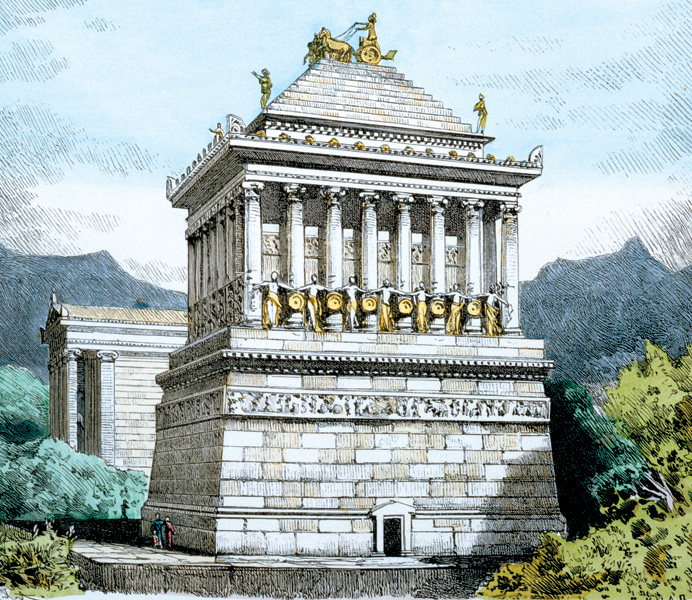
However, Simon sent some to the city Basca to bring away his brother’s bones, and buried them in their own city Modiin; and all the people made great lamentation over him. Simon also erected a very large monument for his father and his brethren, of white and polished stone, and raised it to a great height, and so as to be seen a long way off, and made cloisters about it, and set up pillars, which were of one stone apiece; a work it was wonderful to see. Moreover, he built seven pyramids also for his parents and his brethren, one for each of them, which were made very surprising, both for their largeness and beauty, and which have been preserved to this day (Josephus, Antiquities 13.6.6).
These descriptions indicate that, like the Mausoleum at Halicarnassus, the tomb of the Maccabees consisted of a tall podium with a temple-like building surrounded by columns and capped by a pyramidal roof (or in the case of the tomb of the Maccabees, seven pyramids, one for each family member, including Simon himself). As archaeologist Andrea Berlin has pointed out, none of these features is found in earlier Jewish or Phoenician tombs in Palestine.1 The tomb of the Maccabees retains the ancient tradition of family burial in a rock-cut tomb but adds Greek-style exterior decoration and a monumental marker. The Jews referred to such monumental tomb markers as a nefesh (Hebrew for “soul”).
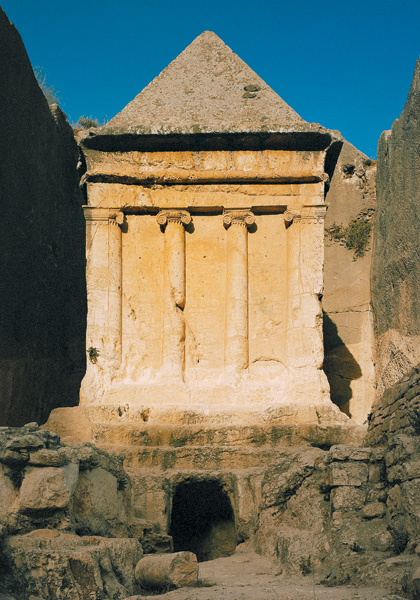
Hellenistic influence on the Hasmoneans can also be seen in their adoption of Greek names, beginning with Simon’s immediate successor, who preferred the Greek name John Hyrcanus over his Hebrew name Yohanan.2
A Hasmonean-period tomb in Jerusalem called Jason’s Tomb demonstrates that Jerusalem’s elite soon imitated the new tomb style introduced by Simon. Jason’s Tomb is located in the western Jerusalem neighborhood of Rehavia3 and is so called because a graffito incised on one of the walls asks the visitor to lament the death of Jason.4 Jason’s Tomb continues the earlier tradition of rock-cut burial caves in Jerusalem, but with several Hellenistic innovations: A large stone pyramid (an example of a nefesh) was constructed above the tomb. The tomb was approached through a series of long, open courtyards leading to a porch in the front of the tomb that was supported by a single Doric (Greek-style) column. This column was set between the projecting ends of the porch walls (an arrangement described in Greek architecture as in-antis; the antae are the ends of the porch walls). The porch gives access to two rooms: a burial chamber and a charnel room. Instead of having rock-cut benches like the First Temple period tombs, the burial chamber in Jason’s Tomb has loculi (in Hebrew kokhim). Loculi are long niches that were cut into the walls, each for an individual burial. Like the pyramidal marker and the porch with a column, loculi reflect Hellenistic influence. Loculi are common in tombs at Alexandria in Egypt, which was the cultural center of the Hellenistic world. They make their first known appearance in Palestine at Maresha, a site south of Jerusalem that was inhabited by Hellenized Phoenicians from Sidon and by Idumeans (descendants of the Biblical Edomites).
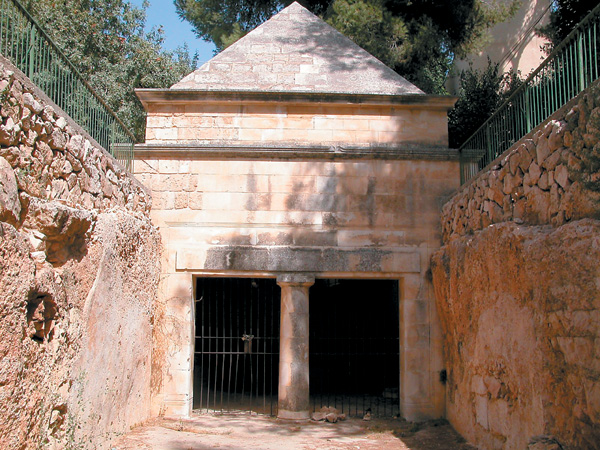
Instead of depositing the remains of earlier burials in a pit or repository (to make room for more burials), as in the First Temple period tombs, the bones cleared out of the loculi in Jason’s Tomb were placed in a charnel room. Beginning in about 20-10 B.C.E., the practice of placing bones from the loculi in a charnel room or pit changed to placing the bones in stone boxes called ossuaries. Ossuaries remained common in rock-cut tombs in Jerusalem until the destruction of the city by the Romans in 70 C.E.

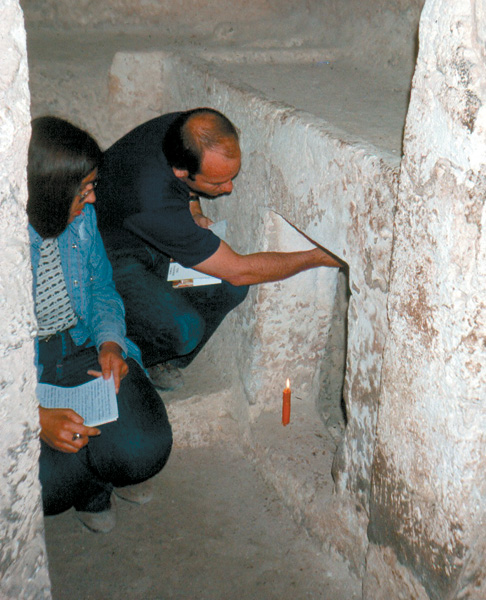
Most of the features that appear in Jason’s Tomb remained characteristic of Jewish rock-cut tombs in Jerusalem until the end of the Second Temple period in 70 C.E.: a porch in front of the tomb’s entrance, sometimes with two columns in-antis; loculi cut into the walls of the burial chambers; and a large pyramidal, conical or columnar marker constructed over the tomb. In addition, the use of ossuaries replaced the charnel room. Rock-cut tombs with these features surround Jerusalem on the north, east and south. Well-known examples include the Tomb of Bene Hezir in the Kidron Valley, the Tomb of Queen Helena of Adiabene (the so-called Tomb of the Kings) near the American Colony Hotel in East Jerusalem, the Sanhedria tombs (in the modern neighborhood of Sanhedria, in north Jerusalem) and Nicanor’s Tomb on Mount Scopus.
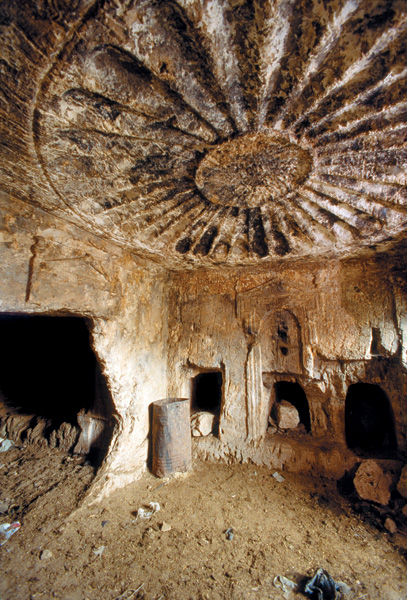
When Jesus’ body was removed from the cross on the eve of the Jewish Sabbath (Matthew 27:57–59, 28:1; Mark 15:33–34, 42–43; Luke 23:44, 50–54; John 19:31), his followers, all observant Jews, were faced with a problem. Jewish law requires burial within 24 hours (Deuteronomy 21:22), and burials are prohibited on the Sabbath. Therefore Jesus had to be buried before sundown on Friday, when the Jewish Sabbath begins. Since there was no time to prepare a grave before the beginning of the Sabbath, Joseph of Arimathea placed Jesus’ body in his family’s rock-cut tomb. The Synoptic Gospels (Matthew, Mark and Luke) are in broad agreement in their description of this event:5
Although it was now evening, yet since it was the Preparation Day, that is, the day before the Sabbath, Joseph of Arimathea, a highly respected member of the council, who was himself living in expectation of the reign of God, made bold to go to Pilate and ask for Jesus’ body ... And he [Joseph] brought a linen sheet and took him down from the cross and wrapped him in the sheet, and laid him in a tomb that had been hewn out of the rock, and rolled a stone against the doorway of the tomb (Mark 15:42–46).
In the evening a rich man named Joseph of Arimathea, who had himself been a disciple of Jesus, came. He went to Pilate and asked him for Jesus’ body ... Then Joseph took the body and wrapped it in a piece of clean linen, and laid it in a new tomb that belonged to him, that he had cut in the rock, and he rolled a great stone over the doorway of the tomb, and went away (Matthew 27:57-60).
Today many scholars believe that since crucifixion was a sadistic and humiliating form of corporal punishment reserved by the Romans for the lower classes (including slaves), Jesus “died a criminal’s death on the tree of shame.”6 John Dominic Crossan, for example, argues that Jesus would not have been buried at all, but would have been eaten by dogs. In my opinion, the notion that Jesus was unburied or buried in disgrace is based on a misunderstanding of the archaeological evidence and of Jewish law. Jesus was condemned by the Roman authorities for crimes against Rome, not by the Sanhedrin (Jewish council) for violating Jewish law. The Romans used crucifixion to maintain peace and order and punish rebellious provincials for incitement to rebellion and acts of treason. Although victims of crucifixion were sometimes left on their crosses for days, this was not usually the case.7 According to the Gospel accounts, Pontius Pilate approved Joseph of Arimathea’s request to remove Jesus’ body from the cross for burial. Presumably Joseph had to make this special request because he wanted to ensure that Jesus received a proper burial before the beginning of the Sabbath.
After Judea came under direct Roman rule with Pompey’s conquest in 63 B.C.E., crucifixion was imposed only by the Roman authorities. Those found guilty by the Sanhedrin of violating Jewish law were executed by stoning (like Jesus’ brother James), or were burned, decapitated or strangled: “Four modes of execution were given in the court: stoning, burning, decapitation and strangulation” (Mishnah Sanhedrin 7:1). According to Biblical law (Deuteronomy 21:22), the bodies of executed criminals could be hanged for the purpose of public display only after they were already dead. The hanging of an already executed criminal is described in the Mishnah (the legal corpus of rabbinic Judaism) as follows: “How do they hang him? They drive a post into the ground, and a beam juts out from it, and they tie together his two hands, and thus do they hang him” (Mishnah Sanhedrin 6:4). This passage describes the hands of the deceased being tied together and the body dangling from a pole. In contrast, Roman crucifixion involved spreading apart the arms of a live victim so that he or she could be affixed to the crossbeam by ropes or nails.8
The following passage from Josephus indicates that the Jews buried victims of Roman crucifixion in accordance with Jewish law: “Nay, they proceeded to that degree of impiety, as to cast away their bodies without burial, although the Jews used to take so much care of the burial of men, that they took down those that were condemned and crucified, and buried them before the going down of the sun” (Jewish War 4.5.2).
The Mishnah attaches no stigma to crucifixion by the Roman authorities and does not prohibit victims of crucifixion from being buried with their families. In contrast, felons who were executed for violating Jewish law could not be buried in family tombs or burial grounds: “And they did not bury [the felon] in the burial grounds of his ancestors. But there were two graveyards made ready for the use of the court, one for those who were beheaded or strangled, and one for those who were stoned or burned” (Mishnah Sanhedrin 6:5).
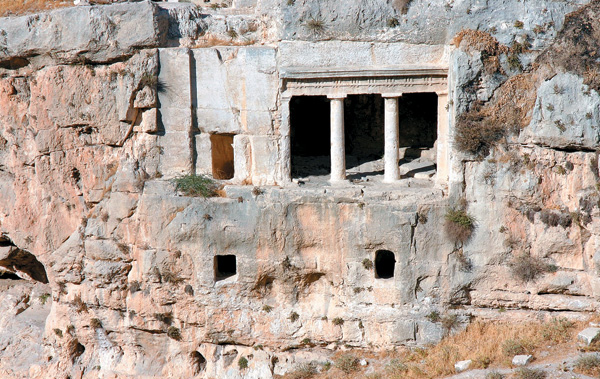
Only one crucifixion victim—a man named Yehohanan—has ever been discovered and identified by archaeologists.9 Yehohanan’s remains were found in an ossuary in a rock-cut tomb in Jerusalem. According to Crossan, Yehohanan’s interment in a rock-cut family tomb is “exceptional and extraordinary” because victims of crucifixion would not have received an honorable burial.10 However, as I have just shown, Jewish law does not prohibit the burial of victims of crucifixion in family tombs. Crossan argues that “with all those thousands of people crucified around Jerusalem in the first century alone, we have so far found only a single crucified skeleton, and that, of course, preserved in an ossuary. Was burial then, the exception rather than the rule, the extraordinary rather than the ordinary case?”11
In my opinion, the exact opposite is the case: The discovery of the identifiable remains of even a single victim of crucifixion is exceptional. Crossan’s assumption that we should have the physical (archaeological) remains of additional crucified victims is erroneous for several reasons. First, with one exception (the repository in the late First Temple period cemetery at Ketef Hinnom referred to earlier), not a single undisturbed tomb in Jerusalem has ever been discovered and excavated by archaeologists. This means that even in cases where tombs or ossuaries still contain the original physical remains, the skeletons are often disturbed, damaged or incomplete. Second, the wealthy Jerusalemites who owned rock-cut tombs with ossuaries favored the preservation of the status quo through accommodation with the Romans. Presumably, relatively few of them were executed by crucifixion. Instead, the majority of victims crucified by the Romans belonged to the lower classes—precisely those who could not afford rock-cut tombs. Third, and most important, the nail in Yehohanan’s heel was preserved only because of a fluke. As one authority has observed:
The most dramatic evidence that this young man was crucified was the nail which penetrated his heel bones. But for this nail, we might never have discovered that the young man had died in this way. The nail was preserved only because it hit a hard knot when it was pounded into the olive wood upright of the cross. The olive wood knot was so hard that, as the blows on the nail became heavier, the end of the nail bent and curled. We found a bit of the olive wood (between 1 and 2 cm) on the tip of the nail. This wood had probably been forced out of the knot where the curled nail hooked into it. When it came time for the dead victim to be removed from the cross, the executioners could not pull out this nail, bent as it was within the cross. The only way to remove the body was to take an ax or hatchet and amputate the feet.12
In other words, the means by which victims were affixed to crosses usually leave no discernable traces in the physical remains or archaeological record. Some victims were bound with ropes, which were untied when the body was removed from the cross. When victims were nailed to a cross, the nails had to be pulled out so that the body could be taken down. This is exactly how the apocryphal Gospel of Peter (6:21) describes Jesus’ crucifixion: “And then they drew the nails from the hands of the Lord and placed him on the earth.” The nail in Yehohanan’s ankle, on the other hand, was preserved only because it bent after hitting a knot in the wood and therefore could not be removed from the body.
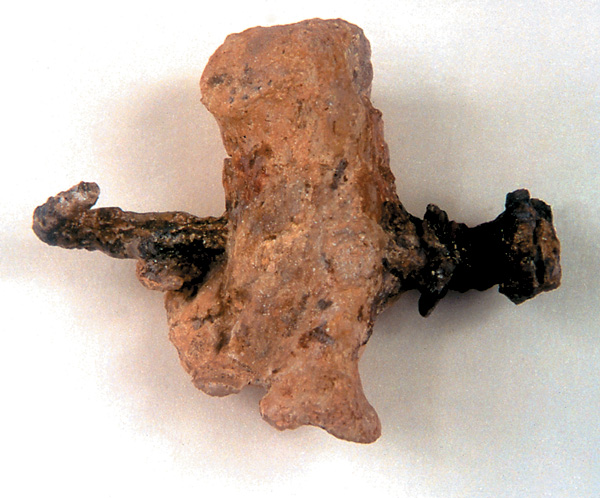
Jesus came from a family of modest means that presumably could not afford a rock-cut tomb. Had Joseph of Arimathea not offered Jesus a spot in his family tomb, Jesus likely would have been disposed of in the manner of the poorer classes: in an individual trench grave dug into the ground. This method of burial is similar to the way many dead are buried today. In ancient trench graves, the body of the deceased was wrapped in a shroud and sometimes placed in a wooden coffin. The body was then laid in a hollowed-out space at the base of the trench. After the trench was filled in, a rough headstone was often erected at one end. The headstones are uninscribed, although some may once have had painted decoration or inscriptions that have not survived. Because trench graves are poor in finds and are much less conspicuous and more susceptible to destruction than rock-cut tombs, relatively few examples are recorded.13

In and around Judea examples of trench graves have been found at Qumran, where members of a Jewish sect were buried,14 at a cemetery near Jerusalemb and in a cemetery near the eastern shore of the Dead Sea.c 15
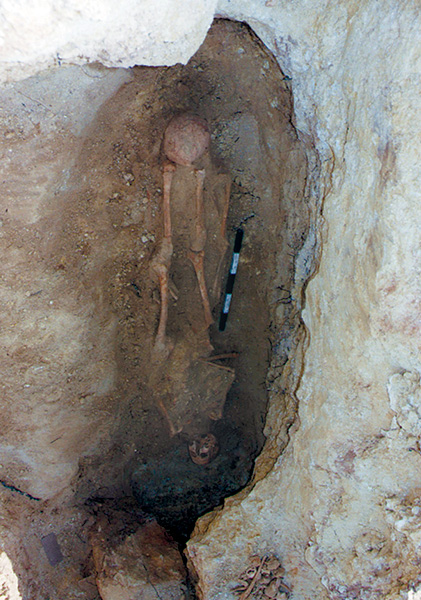
When the Gospels tell us that Joseph of Arimathea offered Jesus a spot in his tomb, it is because Jesus’ family did not own a rock-cut tomb and there was no time to prepare a grave—that is, there was no time to dig a grave, not hew a rock-cut tomb—before the Sabbath. It is not surprising that Joseph, who is described as a wealthy Jew, perhaps even a member of the Sanhedrin, had a rock-cut family tomb. The Gospel accounts apparently describe Joseph placing Jesus’ body in one of the loculi in his family’s tomb. The “new” tomb mentioned by Matthew probably refers to a previously unused loculus. The Gospels include an accurate description of Jesus’ body being wrapped in a linen shroud. When Joseph departed, he sealed the entrance to the tomb by blocking the doorway with a rolling stone.d 16
Joseph’s tomb must have belonged to his family because by definition rock-cut tombs in Jerusalem were family tombs. There is no evidence that the Sanhedrin or the Roman authorities paid for and maintained rock-cut tombs for executed criminals from impoverished families. Instead, these unfortunates would have been buried in individual trench graves or pits. This sort of tradition is preserved in the reference to “the Potter’s Field, to bury strangers in” (Matthew 27:7–8).e
Unlike Crossan, who “cannot find any detailed historical information about the crucifixion of Jesus,”17 I believe that the Gospel accounts of Jesus’ burial are largely consistent with the archaeological evidence. Although archaeology does not prove there was a follower of Jesus named Joseph of Arimathea or that Pontius Pilate granted his request for Jesus’ body, the Gospel accounts describing Jesus’ removal from the cross and burial are consistent with archaeological evidence and with Jewish law.

